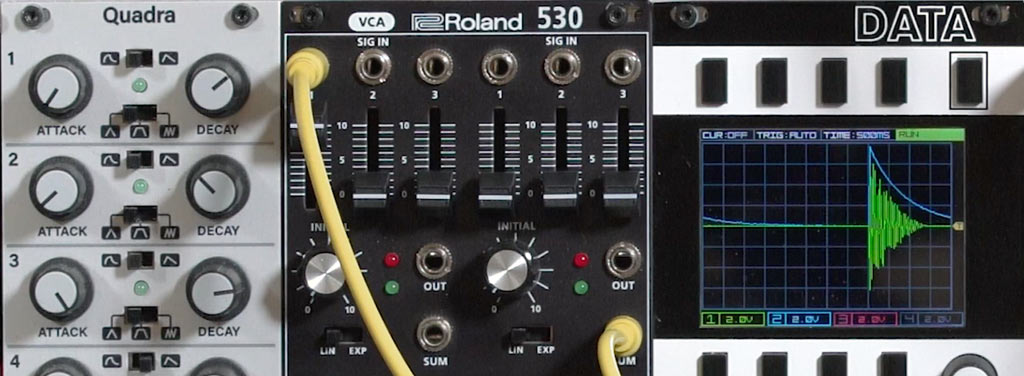Some VCAs are labeled as having “linear” response, some are labeled as having “exponential” response, and some have a switch or even a continuously variable control to go between the two. Which one should use you use, and when?
Of course, the best answer is “whichever one sounds best in a particular situation,” followed by “have one that can do both, just in case.” But there are common starting points you can use, especially when you’re new to patching a modular.
The following movie is a quick demonstration of linear vs. exponential VCA and envelope settings, using the Roland 530 Dual VCA and Intellijel Quadra envelope generator. For more details, keep reading after the movie below:
Enveloping Loudness
In general, our ears have a logarithmic response to loudness. To adjust the volume level of a signal destined for our ears, you want to have the inverse – an exponential response – somewhere in the patch, especially during the decay or release phases of your sound so it is slow to approach silence, which is where our ears are most sensitive. Your two choices are to have an exponential envelope and a linear VCA, or a linear envelope and an exponential VCA.
However, it’s not quite that straightforward. There are exceptions to every rule, but in general, many prefer a logarithmic – not exponential – attack that rushes up quickly in level and then slows down as it approaches the loudest part of a sound. (Different envelope generators “truncate” this attack and start the decay cycle at different parts of the rush-up and tail-off; that’s what makes them sound different.) An example of a truncated logarithmic attack, an exponential decay, and a linear release is shown in the “thumbnail” image for the movie below.
It’s relatively easy to design an envelope shape that does this – indeed, most “exponential” envelope generators have logarithmic attacks. But it’s more difficult to design a VCA that automatically switches between logarithmic response when the sound is getting louder and an exponential response when it is getting softer –in fact, I’m not aware of one that does. (Let me know in the Comments below if you do!)
Here is an excerpt from my Eurorack Expansion course that demonstrates the differences between linear, exponential, and logarithmic envelope shapes using one of my favorite envelope generators overall, the WMD MultiMode Envelope:
Given these choices, I prefer to use linear VCAs for enveloping loudness in a patch, paired with an envelope generator that has a logarithmic attack shape and an exponential decay and release shape.
Note that some envelope generators – especially those based on “slope” generators – have exponential attack curves, which give that playing-in-reverse sound. If you always use fast attacks, this isn’t an issue, and is actually a benefit if you’re trying to create “backwards” sounds. But be aware that in many cases, exponential attack+decay is not necessarily what’s going to sound “natural.”
If you always use fast attacks, you can also use a linear envelope shape and an exponential VCA, as demonstrated starting at 2:53 in the first video above using the Roland 530 and Intellijel Quadra.
Controlling Volume
An exception to the above “rule” is if you are trying to control volume – such as when mixing or panning audio. In this case, you are often better off with a linear control for a voltage (such as a steady bias voltage or constant modulation source like an LFO, routed through a linear attenuator) connected to an exponential VCA. This is demonstrated starting at 5:21 in the first movie above.
Following the “one of them should be exponential” logic, you’d also be fine with an exponential control over your voltage connected to a linear VCA. However, if both are linear or both exponential, you may find you have very little resolution over a portion of the volume range, as seen from 6:02 forward in the first movie above.
What About Modulation?
With modulation – such as controlling the depth of one oscillator frequency modulating another, or controlling an LFO going to a filter – you are often dealing with control voltages that are typically managed using a linear scale. Therefore, a linear VCA may be better for other modulation duties. However, it is great to have a switch or continuous control for the response curve of the VCA, so you can try different options and see which gives you the best sound or “feel” for what you’re trying to accomplish.
I want to end by encouraging you to break the rules I’ve laid out above, and seeing hearing what works best in each situation. To do that, you’d really prefer to have both envelope generators and VCAs with switches (or even better, continuous controls) that go between linear and exponential response. But if you’re just starting out, or in a hurry, the “rules” above will give you a quick start.



very informative article, and just what i was looking for. i am a math person and i always forget!
Big help! Thanks
I came to this page as I’m looking into getting a Wavefonix w314. However, when you order one you have to choose between either/or an exponential VCA or linear VCA. Could you maybe give me a little advice on how I should make the choice between the two?
Thanks in advance – Joe
Here’s the link to Wavefonix’s page so you can see the other modules: https://www.wavefonix.com/product-page/w314-modular-synthesizer
The short answer is: Most of the time, you want a linear VCA; if you are focusing on percussive sounds, some prefer an exponential VCA. There is also a movie in the original Learning Modular Synthesis course that compares the two.